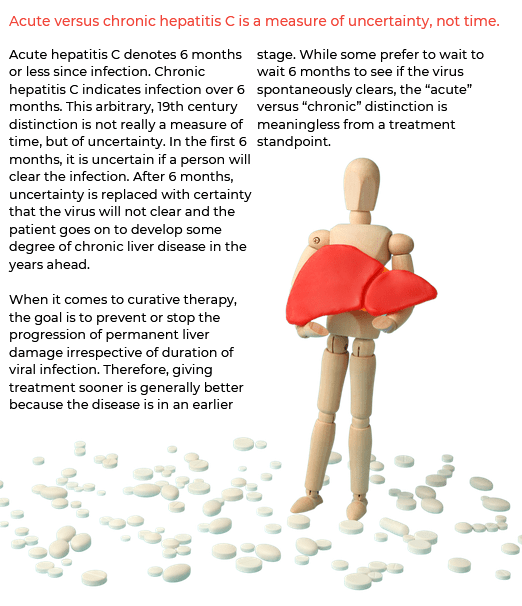“Yellow jaundice”, a redundant phrase that literally means “yellow yellow,” is a sign of a very sick liver. One day when I was in private practice, a quiet woman with chronic hepatitis C infection came to see me because she was the color of a lemon. As I examined her fluid-filled belly, she sheepishly admitted that she’d fallen off the bandwagon and, unbeknownst to her family, had started drinking alcohol again. Her husband was in the waiting room, and she begged me not to tell him. I consulted my hospitalist colleague who admitted her to the hospital. She died a week later from fulminate liver failure.
A year later in 2014, headlines trumpeted new drugs that cured 95% of hepatitis C cases. It was then, as I rode the wave of optimism following the first cure for a chronic viral infection, that I drafted this article. I thought I was looking toward a future where hepatitis C would become an easily treatable but annoying infection, like syphilis. Almost a decade later, I see that I was wrong for a lot of reasons.
Syphilis is an interesting comparison because it was a chronic disease for most of human history. Syphilis is seeded by a sexually transmitted bacteria that, when left untreated, can cause multi-stage disease. Over the course of decades, it can incite serious problems in almost any internal organ. In the 1940s, syphilis cases plummeted to tiny numbers owing to improved diagnostics, highly effective antibiotics and prevention initiatives. Today, it is practically taken for granted that taking a short, curative course of antibiotics spares a person from decades of debility. While acute cases of syphilis continue to be diagnosed at a low hum, punctuated by an occasional outbreak, I’ve only seen one case of advanced syphilis (neurosyphilis) in my 22 years of studying and practicing internal medicine in the U.S.
Hepatitis C turned out to be a totally different story. The only commonalities it shares with syphilis are that it’s an infectious disease that can cause life-long debility and severe complications. Otherwise, it is a virus, not a bacteria, that attacks the liver, spreads largely by blood-to-blood contact and is less frequently sexually transmitted. Some people who contract the hepatitis C virus spontaneously clear it and are no longer infected. Until recently, scientists thought that spontaneous clearance happened in 15 to 20% of people, but we now see it’s closer to 50%1. Is that because the infection has changed, the environment has changed or because of better data collection? Who knows. Either way, we don’t know in whom it will resolve or persist. Of those who do not clear the infection, 20% go on to develop severe liver scarring and cirrhosis, and 20% of those cirrhosis patients develop liver cancer within a few decades2. A cure, ideally, prevents these outcomes, like penicillin did for syphilis. But that is not what happened, at least at the population level.
By the early 2000s, hepatitis C treatments were brutal. The hope of cure lay at the end of a yearlong journey through interferon-based therapy that caused debilitating side effects like severe depression, nausea, headaches, and the other flu-like symptoms. If patients could complete treatment, they faced a high risk of relapse. When well-tolerated and highly effective cures came to market in 2014, it was a welcome reprieve. Known hepatitis C cases were rising in the U.S. and presumably so were unknown cases in its shadow3. With a cure in hand, the headlines celebrated that for the first time, eradication of hepatitis C was possible in the not-so-distant future.
Now, almost a decade later, hepatitis C infection rates in the U.S. continue to rise, while administration of curative therapy has steadily declined4. Cures should reduce viral infection rates and transmission since theoretically, fewer people would have the disease to pass to another, right?

A common practice today is to look for obvious scapegoats to blame for these unexpected and dissatisfying trends. In this case, there are three main culprits: intravenous drug abusers, cost of treatment, and unidentified cases of hepatitis C.
First, since intravenous drug abusers (IVDA) are the source of 60% of acute hepatitis C cases and up to 50% of abusers have hepatitis C, they win the attention of prevention initiatives and often need curative therapies5,6. Given that IVDA patients may struggle with unemployment, poverty, incarceration, lack of health insurance, have difficulty adhering to prolonged medical regimens, and 85% of the time relapse into drug abuse within a year of rehabilitation, they represent a challenging population to heal. Additionally, recent opioid trafficking concerns have hitched their cart to the rise in hepatitis C statistics by way of reportedly rising number of injection drug users.
Second, the cost of curative therapy is prohibitively expensive. At $1000 or more a day, completing a 12- to 24-week treatment regimen is outrageous for anyone, including insurance companies. Another major problem is that the cure, which works by directly inhibiting the virus’ replication cycle, does not produce the lasting immunity needed to prevent reinfection. A second round of treatment is effective, but it is just as expensive as the first.
Reconsideration of the IVDA population reveals that: 1) they are less likely to be able to pay for the cure, 2) if it is paid for, they have challenges that reduce their likelihood of completing the course, and 3) even if they complete therapy, there is high risk of reinfection from ongoing or relapsing IVDA. Plus, about 50% of them will spontaneously clear the infection within 6 months which sometimes can confer immunity from reinfection. While this half does not need treatment, that is knowable only in hindsight, and they can still spread the virus to others until they clear it.
Here’s the brutal truth: Why buy expensive cures for people when up to half will spontaneously clear the infection and the rest are likely to contract it again? It’s the fodder of heated debates until treatments become cheaper and faster. Screening for silent hepatitis C in more stable populations who can afford and reliably complete the treatment contribute to today’s notion of health disparities. The “just pay for it all” argument, motivated by good intentions to help those with psychosocial issues, makes the problem worse, not better. It doesn’t make it right or good, it just makes it reality.
Finally, rising hepatitis C cases are blamed on a nebulous stew called “people who don’t know they have it.” Here’s the rub: although IVDA is the source of 60% of acute cases, it’s been associated with only 20 to 50% of the chronic cases6. Not only is explaining the source of those chronic cases problematic, but so is measuring or estimating the undiagnosed stew. Observers are often obsessed with obtaining “accurate data,” but accurate data is not our problem. Accurate interpretation of the data is. We’re so lost in generating data and calculating statistics that we’ve lost sight of the relevant context needed to understand what is really going on with hepatitis C.
For example, in 2018, there were 3621 newly reported cases of acute hepatitis C and 137,713 newly diagnosed chronic cases3. Given that half of the acute cases could theoretically resolve, that doesn’t leave enough cases to feed the number of chronic cases observed. In today’s way of thinking, this necessitates a reverse engineering trick to estimate the missing or undetected individuals. In 2018, the CDC estimated that there were 50,300 acute cases of hepatitis C, 93% of which went undiagnosed. While many view this as a failure of healthcare to reach treatable patients, what I see is a total failure to understand hepatitis C covered up by statistical shell games that create more problems than they solve.
For chronic hepatitis C, the situation is even messier. There are two peaks where people are diagnosed: age 25 to 35 and age 55 to 653. The older group was living well before the virus was recognized in 1989, and plausibly could have been exposed via transfusion, needle sticks or sexual contact. As for the surge in the younger group there’s the default explanation: an assumed resurgence in IV drug abuse. However, since IVDA only accounts for 20 to 50% of chronic cases, it does not adequately explain the majority of chronic cases in younger people. Is it possible that a rise in IVDA contributes to rising hepatitis C? Sure, but don’t be fooled to thinking that’s a complete explanation. Despite the common stigma, the link between IVDA and hepatitis C is just not as strong as we want it to be. Something else is going on outside our awareness.
Finally, the undiagnosed stew includes a huge variety of people, the majority of whom have never abused IV drugs. They experience hepatitis C infection differently or not at all. While we traditionally treat this population as an unmitigated disease reservoir, what it really represents is near total ignorance about hepatitis C. Why do so many people have no symptoms until decades later, if at all? We think this is because of a mysterious interplay between virus and host. Why is the history of blood exposure needed to transmit hepatitis C often missing? Clinicians typically assume patients don’t recall or are hiding information. What if that is not the reason?
The mess surrounding hepatitis C including how to pay for it, overcoming the socioeconomic challenges needed to eradicate it, and the logistics of identifying and treating everyone are only perceived challenges. The real problem is we still don’t understand hepatitis C, a quandary that not even a vaccine would solve.
It’s time to start with an honest question.
Did we really cure hepatitis C?
Works Cited
- Seo S, Silverberg MJ, Hurley LB, et al. “Prevalence of spontaneous clearance of hepatitis C virus infection doubled from 1998 to 2017.” Clin Gastroenterol Hepatol 2020;18:511–3. PubMed https://doi.org/10.1016/j.cgh.2019.04.035
- Ahar B, Miller R, and Sisson, S. The Johns Hopkins Internal Medicine Board Review, 5th ed. Elsevier Inc 2016, 254-5.
- Centers for Disease Control and Prevention. “Viral Hepatitis Surveillance Report 2018 – Hepatitis C.” Statistics & Surveillance. 28 Aug 2020. Retrieved on 3 March 2023 from https://www.cdc.gov/hepatitis/statistics/2018surveillance/HepC.htm
- Centers for Disease Control and Prevention. “New estimates reveal declines in hepatitis C treatment in the U.S. between 2015 and 2020.” NCHHSTP Newsroom. 8 Nov 2021. Retrieved on 3 March 2023 from https://www.cdc.gov/nchhstp/newsroom/2021/2014-2020-hepatitis-c-treatment-estimates.html
- Ahar, p 255.
- Ferri, F. “Hepatitis C” in Ferri’s Clinical Advisor 2017 . Philadelphia: Elsevier, 2017. 573-5
- Ibid.

